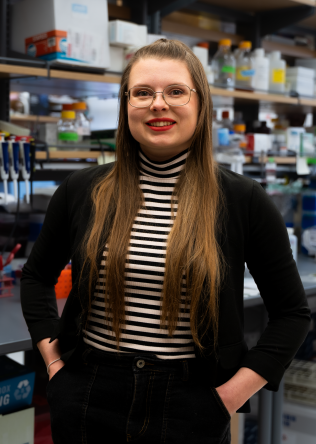Rachael Wolters
Elias Xavier West
I was born and raised in Omaha, Nebraska. I attended Loyola Marymount University, in Los Angeles, and received a BS in biology. Directly after graduating, I joined IGP in the summer of 2020.
In the Skaar lab, I study iron acquisition and homeostasis in C. difficile during infection. I am particularly interested in examining the difference in mechanisms utilized in the presence of different commensals.
Steven Craig Wall, Jr.
Jared Oakes
Parker Joseph Jamieson
Ryan Thomas Fansler
Kaeli Noele Bryant
I am from Greenwood, Indiana and earned my B.S. in Biochemistry at Indiana University in 2020. While at IU, I spent 4 years studying Wolbachia pipientis under Dr. Irene Newton. I joined IGP in 2020 and joined the lab of Dr. Timothy Cover in 2021. When not in lab, I enjoy cooking, rock climbing, and solving crossword puzzles.
Awards and Honors:
Goldwater Scholar, 2019
NSF GRFP Honorable Mention, 2020
I research how CagA, a bacterial oncoprotein made by Helicobacter pylori, is recruited and then secreted into host cells. I am also interested in studying genetic diversity of H. pylori and how it affects the activity of the Cag type IV secretion system.
Sandra S. Zinkel, PhD, MD
My lab is interested in understanding the mechanisms by which normal and malignant cells regulate programmed cell death. Multicellular organisms have devised a tightly regulated, genetically programmed mechanism of cell suicide to maintain homeostasis and to prevent propagation of genetically damaged cells. The discovery of the BCL-2 family of genes uncovered the underlying genetic mechanism of this regulation, as well as a class of oncogenes that governs cell death rather than cell proliferation.
There are two major pathways that regulation programmed cell death: apoptosis and programmed necrosis. Simply, apoptotic cells implode in a relatively immune silent manner. Necrotic cells explode, releasing cellular contents and inciting an immune response- beneficial in settings of infection, but detrimental in settings of chronic damage, where the inflammation eliicited by necrotic cell death amplifies cellular damage. Current studies focus on how programmed cell death regulates homeostasis in the hematopoietic (blood) system. We have found that unrestrained programmed necrosis leads to bone marrow failure in mice that closely resembles the human disease Myelodysplastic syndrome (MDS).
The projects in my lab use hematopoietic cell culture systems, mouse models, immunofluorescence, electron microscopy, as well as flow cytometry and cell death assays to understand the signals and protein interactions that direct hematopoietic cells to die by apoptosis or necrosis. In addition, we use our mouse models to determine the effects of inhibiting necrosis on bone marrow failure and transformation to leukemia. An additional focus is to dissect the mechanism of Bcl-2 family members in mouse models of leukemia. Our studies provide new insights into the interplay between apoptosis and necrosis, and their role in hematopoiesis, bone marrow failure, and leukemogenesis.
Publications on 
Mechanisms by which normal and malignant cells regulate programed cell death or apoptosis following DNA damage









